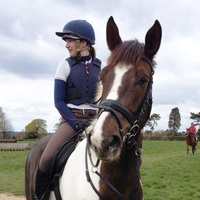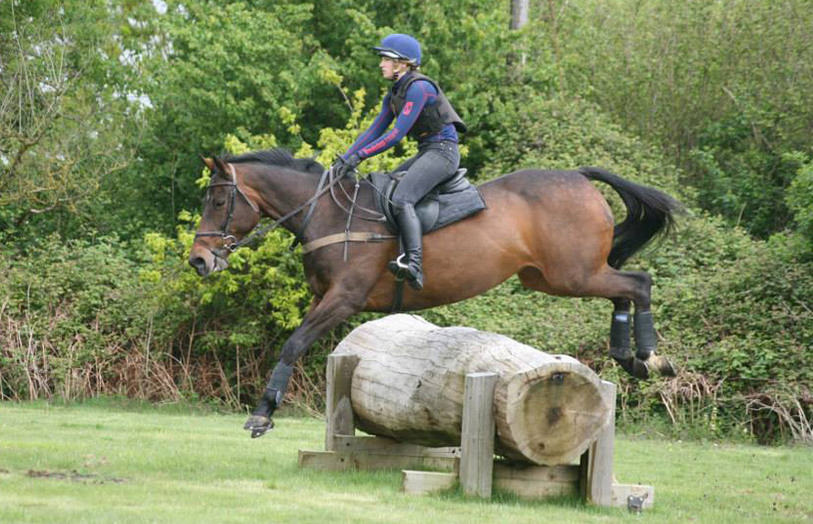
Are You & Your Horse Ready For Bitting Advice? The Steps You Need To Consider First
Equestrian Advice & Guides All Disciplines
Build your business profile for FREE and expose your services to thousands of potential clients!
Create my profile now!
Eventing season is looming which means it's time to polish up our techniques and combat any underlying issue that you faced last season. A common problem a lot of riders face is holding a straight line while riding cross country. The cross country phase not only becomes bigger as you go up the levels, but the technicality also becomes more difficult. So mastering the foundation is fundamental to ensure you’re bringing those rosettes home this season.
So where do you start? If you struggle with accurately holding that line to a fence then we have two great exercises to try. You don't have to go cross country schooling to practice this, it can all be done at home.
Aim;
This is a great exercise for both horse and rider. Start off with two small poles about 90/100cm in length (if you don't have any just use normal poles), put them on the floor with 3 canter strides between the two poles (20 human strides). Trot over the poles making sure you are looking ahead. You may need to adjust the pole positioning if you feel the horse is reaching for the pole in trot.
At first the horse may find it easier to go around the poles or might even become ‘wobbly.’ When this happens you need to create a channel with your legs for guidance. This means wrapping your legs around the horse keeping them between leg and hand and up into the contact. This in turn will help guide them over the pole. After a few attempts this will become easier. After mastering this in trot, pop them up into canter and do the same as before, making sure you have them up and in front of you. The most important part of this exercise is to make sure you carry on riding in a straight line after the poles.
Time to kick it up a notch. We can now move the poles onto an angle on the floor to bring a technical aspect into the exercise. You can now go back to using normal length poles if easier. Start off with one horse stride between each pole (8 human strides). Depending on how experienced the horse is, most horses will want to follow the angle of the poles rather than going over them at an angle. You will have to be very reactive to prevent the ‘wobble’ feeling from the horse. Ride it like nothing has changed keeping the horse between leg and hand and continue to look forward to the next pole.
Once confidant with this pop them once again into canter and come down over the poles. Make sure you are doing this exercise on both reins. It's natural for the horse and you as a rider to find one rein easier. Try not to only focus on the good rein.
Now that the horse is on the aid and completely responsive to your movements, you can raise the poles off the floor and make three jumps. Make sure you keep yourself in a good posture with good rein contact to help keep them on a straight line. Top tip: don't let the horse drift across the line of the fence. Make sure you sit up after the fence getting them to sit back on their haunches.
Depending on how confident both parties are feeling, pop the horse back into the canter. It’s so important to remember to let the fence come to you. Keep the horse responsive and look down to the end of the school whilst wrapping your legs around the horse to keep them straight and in contact.
Make sure this is done on both reins and only build the fence size up when you are both completely confident. Build the middle fence like the diagram and ride to the middle point of the cross. This gives you a point to aim for. As soon as you land you want them on your aids and sitting back waiting for the next fence.
Points to be aware of:
Another problem you may face is holding your line to a fence but then the horse drifts to the left or right on takeoff. This is a great exercise to try with young horses or horses that drift when coming to a fence.
Aim;
Start off with the fence on an angle with two canter poles in front of the fence. The canter poles are there to help keep the horse up in front of you and keep them more in between leg and hand. A fence is easier to meet on an angle but also makes it easier for the horses to fall out through their shoulder, hence drifting to the left or right. Start with a small fence with two jumping poles on an angle to create a triangle shape. The smaller the point of the triangle the more the horse will snap up, preventing them from drifting left or right over the fence.
Just like the last exercise, make sure you ride in a straight line afterward. You can build this up over a course of fences or down a guide. If you are riding a young horse make sure the point of the triangle is further apart. It can be quite daunting and they may get confused.
Top tip: Make sure your hands are up about 15cm from the horse’s wither. Don't let your hands sit in your lap. This will also make it easier to keep the horse on your aids.
Once you feel confident remove the poles but change nothing in your riding. Let the fence come to you and always look ahead to your next fence while keeping the contact.
Holding a straight line on a cross country course all comes from the foundation built in the beginning at home. Build it up slowly and the rest will follow. Always make sure you have a good approach and a great canter. Coming to a fence on a lackluster canter is asking for trouble. Always make sure your horse is forward and in front of you.
If you struggle with the canter then you may benefit from lots of pole work exercises to ensure the horse is working from behind.


